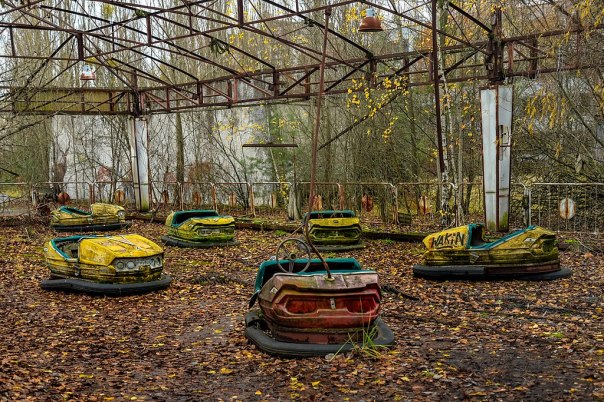The true impacts of the 1986 nuclear disaster on people and the environment
By Beyond Nuclear staff
The strategy of the desperate is to downplay and dismiss. A major nuclear disaster is more than just an inconvenient truth for an industry that doesn’t want you to know it kills people. As a result, when a serious nuclear accident happens — arguably always preventable and therefore not strictly an accident — there is a scramble to present the event as largely insignificant.
Many myths are quickly put about, usually centered on how few people immediately died, a completely misleading statistic since nuclear power plant disasters do not usually kill people instantly. But over the long-term, their legacy is indeed both considerable and often deadly.
In the newest edition of our periodic Thunderbird newsletter, we look at the facts about the Chernobyl disaster — and touch on one welcome piece of fiction in the form of a novel.

Children’s shoes, abandoned Pripyat middle school. Photo: Jose Franganillo
The disparities over the death count are used to downplay and even dismiss the terrible and long-lasting after effects of Chernobyl. But focusing only on fatalities also serves to diminish the disaster’s impact. It can take years before fatal illnesses triggered by a nuclear accident take hold. This creates a challenge in calculating just who eventually died due to the accident and who suffered non-fatal consequences.
Exposure to ionizing radiation released by a nuclear power plant (and not just from accidents but every day) can cause serious non-fatal illnesses as well. These should not be discounted. Arguably, neither should post accident psychological trauma.
All the populations affected by Chernobyl have been inadequately studied and monitored — whether they lived inside the former Soviet Union or elsewhere in Europe where the radioactive plume also contaminated lands and people.
The Chernobyl liquidators are a group most often cited as they were dispatched to the stricken nuclear plant in the immediate aftermath, as well as for at least the subsequent two years, to manage and endeavor to “clean up” the disaster. They included military as well as civilian personnel such as firefighters, nuclear plant workers and other skilled professionals. More information is still emerging on their fate and that of their descendants.
It is generally accepted that there were about 800,000 liquidators but only a small portion of them were subject to medical examinations. By 1992 it was estimated that 70,000 liquidators were invalids and 13,000 had died. These estimates rose to 50,000 then to 100,000 deaths among liquidators in 2006. By 2010, Yablokov et al. estimated a death toll of 112,000 to 125,000 liquidators.

Paris demonstration, April 2010, memorializing Chernobyl liquidators and calling for an independent WHO
Even the Russian authorities admit findings of liquidators aging prematurely, with a higher than average number having developed various forms of cancer, leukemia, somatic and neurological problems, psychiatric illnesses and cataracts. The UN Office for the Coordination of Humanitarian Affairs found a statistically significant increase in leukemia among Russian liquidators who were in service at Chernobyl in 1986 and 1987.
There are similar findings among general populations although, again, these have been hard to track. While countless numbers may have eventually died from Chernobyl-related illnesses, equal or even greater numbers likely survived and were forced to live with debilitating and chronic medical conditions as well as psychological trauma.
The widely debunked 2003-2005 Chernobyl Forum accounting is the record most often quoted, and yet it is utterly compromised. It was produced by the nuclear promoting International Atomic Energy Agency, which ignored its own data that indicated there would be 9,000 future fatal cancers in Belarus, Russia and Ukraine. The IAEA instead claimed there would be no more than 4,000. Both numbers are gross underestimations.
The report focused only on the most heavily exposed areas in making its predictions. It ignored the much larger populations in the affected countries as a whole, and in the rest of the world, who have been exposed to lower but chronic levels of radiation from Chernobyl.
The 2006 TORCH Report exposed the flaws in the Chernobyl Forum as did IPPNW in its own report. TORCH predicts at least 30,000 and maybe as many as 60,000 excess cancer deaths worldwide due to the accident. An analysis of 5,000 Russian studies, by the late Soviet scientist, Alexey Yablokov and colleagues, puts the number of premature deaths due to Chernobyl as likely to soar as high as one million people. There is also a 2016 update to the original TORCH report.
In other studies, elevated rates of thyroid cancer were discovered in Belarus, Ukraine and Russia, particularly among children, where the preventive pill, potassium-iodide (KI), was not distributed. In Poland, where KI was distributed, incidences were extremely low.
Outside the former Soviet Union, impacts were also significant with about 40% of Europe’s land surface radiologically contaminated.

Abandoned fairground, Pripyat. Photo: Jose Franganillo
Dr. Wladimir Wertelecki, a physician and geneticist, discovered, alarmingly, that the negative health effects caused by Chernobyl did not stop with those exposed directly. His research, focused in Polissia, Ukraine, noted birth defects and other health disturbances among not only those who were adults at the time of the Chernobyl disaster, but their children who were in utero at the time and, most disturbingly, their later offspring.
Pierre Flor-Henry in his research, even found medical changes resulting from apparent psychological responses. He noted that schizophrenia and chronic fatigue syndrome among a high percentage of liquidators were accompanied by organic changes in the brain. This suggested that various neurological and psychological illnesses could be caused by exposure to radiation levels between 0.15 and 0.5 sieverts.
Nevertheless, the IAEA and the World Health Organization (WHO), given their supposedly august credentials, are cited as the bodies of record on post-Chernobyl fatalities and health impacts. But there is a fundamental reason why the WHO cannot be trusted.
On May 28, 1959, the WHO made an agreement with the IAEA that would effectively gag the agency on any nuclear issue from that day forth. The agreement gave the IAEA a veto on any actions by the WHO that relate in any way to nuclear power. The IAEA’s stated mission is to “accelerate and enlarge the contribution of atomic energy to peace, health and prosperity throughout the world.” So clearly, there is a major conflict of interest at work here.
Not only people but animals — both wild and domestic — have been harmed by the Chernobyl disaster. This damage is likely permanent as it has been passed down through generations via DNA. The research by Dr. Timothy Mousseau finds birds around Chernobyl with low to zero sperm counts, cataracts, diminished brain size and truncated longevity. Stray dogs continue to proliferate around the Chernobyl nuclear site. Wild boars in Europe remain too radioactive to eat. Insects have mutated and micro-organisms have disappeared.
There are some bright and hopeful signs however. Much humanitarian work has gone on over the decades to bring relief to those suffering the Chernobyl after-effects. The disaster — and the subsequent one at Fukushima — changed the minds of the leaders in power at the time, Mikhail Gorbachev and Naoto Kan. These men now advocate for an end to the use of nuclear power. Several countries renounced nuclear power in the wake of these disasters or reinforced their policies to phase out nuclear and turn to renewables.
And there is even some welcome fiction about Chernobyl, in the form of a searingly beautiful and haunting first novel by Irish writer Darragh McKeon. We encourage you to read All That Is Solid Melts Into Air for a vivid account of the very real characters he portrays living through the Chernobyl ordeal.
Download and print our Thunderbird newsletter — Chernobyl: The Facts — here.
Cover photo by Jose Franganillo.
 Beyond Nuclear International
Beyond Nuclear International
Pingback: The true impacts of the 1986 nuclear disaster on people and the environment | Nuclear Information
Pingback: Chernobyl Haunts - The Colorado Coalition
Pingback: Merging threats – nuclear and climate news « nuclear-news
Pingback: To 27 April – Nuclear and Climate News | Nuclear Australia
Pingback: The true impacts of the 1986 nuclear disaster on people and the environment « nuclear-news
Pingback: Chernobyl Post-Mortem | Political Film Blog
Pingback: The Facts About Chernobyl | Beyond Nuclear International – REMEMBER FUKUSHIMA